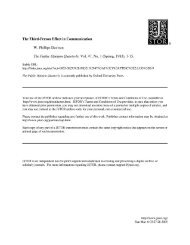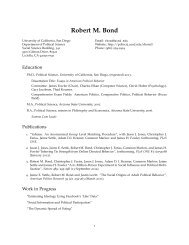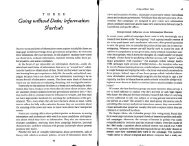Chapter 6 Why Authoritarian Parties? The Regime Party as an ...
Chapter 6 Why Authoritarian Parties? The Regime Party as an ...
Chapter 6 Why Authoritarian Parties? The Regime Party as an ...
Create successful ePaper yourself
Turn your PDF publications into a flip-book with our unique Google optimized e-Paper software.
CHAPTER 6<br />
political coalitions <strong>an</strong>d will most likely be lost should the regime or leadership ch<strong>an</strong>ge. In<br />
turn, party members become political hostages of their own career success, with a vested<br />
interest in the perpetuation of the existing regime.<br />
<strong>The</strong> three institutional features of successful authoritari<strong>an</strong> parties identified here con-<br />
tribute to authoritari<strong>an</strong> resilience via <strong>an</strong>other, conceptually separate mech<strong>an</strong>ism, which we<br />
may call direct political control. This mech<strong>an</strong>ism refers to those <strong>as</strong>pects of party activity<br />
that are aimed primarily at the general population, such <strong>as</strong> political communication, mobi-<br />
lization, intelligence gathering, <strong>an</strong>d the mainten<strong>an</strong>ce of political discipline (see e.g. Friedrich<br />
<strong>an</strong>d Brzezinski 1965; Huntington 1968). Smith (2005), for inst<strong>an</strong>ce, identifies the ability au-<br />
thoritari<strong>an</strong> parties to mobilize their constituencies in times of crisis <strong>as</strong> a key <strong>as</strong>pect of party<br />
“strength”, Geddes (2008) argues that m<strong>as</strong>s parties help dictators to counter threats form<br />
the military, <strong>an</strong>d Magaloni (2008, 723) <strong>an</strong>d Wintrobe (1998, 65) emph<strong>as</strong>ize that long-l<strong>as</strong>ting<br />
parties are essential for effective cooptation. <strong>The</strong> <strong>an</strong>alysis here highlights how particular<br />
features of internal party org<strong>an</strong>ization – the party’s recruitment, promotion, <strong>an</strong>d retirement<br />
policies – ensure that sufficient incentives exist for key segments of the population to join the<br />
party <strong>an</strong>d, in turn, provide the political service that results in the party’s “l<strong>as</strong>ting strength”.<br />
By examining how optimal recruitment, promotion, <strong>an</strong>d retirement policies depend on the<br />
regimes’ resources, ideology, <strong>an</strong>d non-partis<strong>an</strong> opportunities for career adv<strong>an</strong>cement, we gain<br />
a better underst<strong>an</strong>ding of the connection between org<strong>an</strong>izational features of authoritari<strong>an</strong><br />
parties <strong>an</strong>d the potential <strong>an</strong>d limits to their “l<strong>as</strong>ting strength”.<br />
<strong>The</strong> results of this formal <strong>an</strong>alysis both corroborate <strong>an</strong>d qualify existing expl<strong>an</strong>ations<br />
of how authoritari<strong>an</strong> parties contribute to the survival of dictatorships. Brownlee (2007),<br />
Geddes (1999b; 2003), Gehlbach <strong>an</strong>d Keefer (2008), <strong>an</strong>d Magaloni (2006, 2008) argue that<br />
5











